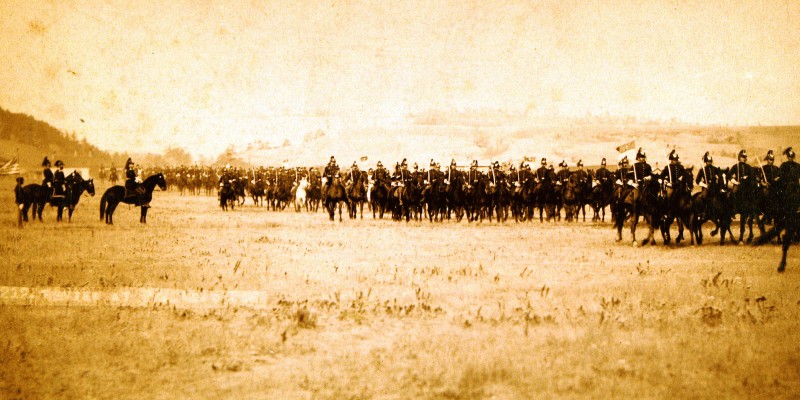Whether or not General Sheridan knew of the concept of Manifest Destiny or had heard the term, he was a believer. Newspaper editor John O’Sullivan popularized the idea in 1839 when he made the case for America’s expansion westward. He wrote an article called “The Great Nation of Futurity,” which eloquently explained the political, economic, and moral reasons why Americans should go forth and spread across the North American continent. The words destiny and progress are prevalent in the piece, and a central tenet of progress was to civilize the Native American tribes, who were seen as archaic and savage. The idea of civilizing the tribes seemed noble at the time, but it was destructive at its core.
O’Sullivan’s missive stated, in part, “. . . We are a nation of progress, of individual freedom . . . freedom of conscience, freedom of person, freedom of trade and business pursuits, universality of freedom and equality.” The great irony of Manifest Destiny, of course, was that universal freedom applied only to the white population. Slavery still flourished in the South, and the only way to civilize the Native American tribes was to destroy their way of life and convert them to the white man’s customs and the Christian religion.
In 1845, six years after O’Sullivan wrote his article, he rallied support for the annexation of Texas and wrote the quote that gave a name to America’s guiding principle of westward expansion. O’Sullivan said that it was Americans’ “manifest destiny to overspread the continent allotted by Providence for the free development of our yearly multiplying millions.”
Westward expansion accelerated in the 1840s and 1850s with the addition of Texas, Kansas, and Nebraska to the Union, and the discovery of gold in California. After the Civil War, Americans raced to blaze new trails to and through the West, and then ditch those old wagon roads as soon as possible for the faster, safer, and easier mode of travel, the railroad.
All of that progress required the subjugation of Native American tribes and their removal from their ancestral lands. Naturally, they wouldn’t leave without a fight. And by the late 1860s, General Phil Sheridan and General William Tecumseh Sherman were advocating all-out war against the tribes. If the tribes wouldn’t submit peacefully and agree to live on the most desolate, undesirable pieces of land on the continent, they would be killed. To the generals’ way of thinking, violent conflict was inevitable. So America might as well be the aggressor and get it over with. The faster it was done, the faster America could say that the West was simultaneously safe and open for business.
While Red Cloud fought his war on the northern plains, members of the tribes of the southern plains signed the Medicine Lodge Treaty of 1867. But, as always, the treaty did little to stop the fighting between the tribes and the soldiers who tried to secure roads to the West for settlers. By the autumn of 1868, General Sheridan was ready to take the first major, coordinated step toward removing or annihilating the Plains Indians.
Sheridan devised a strategy that used three army columns from three different forts on the southern plains. The columns would strike from different directions and use speed and surprise to kill or capture the enemy. But the first stage of the plan featured just one column in action: the Seventh Cavalry led by Lieutenant Colonel Custer. The other two columns, one of which included scouts Wild Bill Hickok and Buffalo Bill Cody, were waylaid by early winter snowstorms.
Custer’s men still called him “General” to honor his brevet rank during the Civil War, but in the smaller postwar army, he was bumped back to lieutenant colonel. Less than a week after Custer’s column departed Fort Dodge in Kansas, his detachment of scouts, led by Major Joel Elliott, found the trail of a Cheyenne village that was led by Chief Black Kettle. Black Kettle had survived the Sand Creek massacre in southern Colorado four years earlier, an event that helped spark Red Cloud’s War. But he would not survive Custer’s assault.
On November 27, 1868, Custer’s men attacked the village along the Washita River near present-day Cheyenne, Oklahoma. The cavalry burned the village, killed combatants and noncombatants alike, and captured 53 women and children. But during the attack, Major Elliott’s detachment of 17 men advanced beyond the main assault force and ran headlong into a charging horde of more than one thousand Kiowa and Arapaho warriors. Black Kettle’s village was small, maybe 250 people total. But beyond his village, tucked into a loop of the Washita River, were two larger villages. Warriors from the Kiowa and Arapaho villages rushed toward the fight at Black Kettle’s village and swarmed Major Elliott’s detachment.
When Custer saw the wave of warriors racing toward his men, he withdrew across the Washita River and marched back to the camp that acted as a staging area for the attack. Custer claimed victory, but he made no attempt to rescue Major Elliott’s detachment or recover the bodies in a timely fashion, and those decisions infuriated Captain Frederick Benteen. Benteen was a close friend of Major Elliott, and Benteen believed Custer cared more for personal glory than the safety of his men. This campaign would seem eerily familiar to Benteen in the future.
Seven years after the Battle of the Washita, General Sheridan stood in President Grant’s office and said it was time to try the same tactic against the tribes of the northern plains who refused to sign treaties or set foot on reservations. Grant reluctantly agreed, but with a caveat: he wanted legal cover for the action. He needed to justify the campaign by saying the tribes broke the Fort Laramie Treaty.
Grant was in a tight spot. He seemed like a man who genuinely appreciated the destructive history of America toward Native American tribes. He didn’t want to continue the policies of previous generations that forced the tribes onto reservations or killed them in the attempt. But most of the country cried out for more land and more resources—namely, gold. And Americans had clearly proven that they were going to move west regardless of Grant’s feelings or opinions. So, Grant talked himself into approving Sheridan’s plan by finding a tepid middle ground. By 1876, it was clear that certain groups within a few tribes were not going to sign a treaty or live on a reservation. Grant could ask for all the legal cover he wanted, and his administration could state as many righteous goals for the campaign as it desired, but Grant had to know that there was a high likelihood of significant bloodshed. Grant had tried to buy the Black Hills, but failed. And he couldn’t hold back the flood of westward expansion. His only choice was to compartmentalize his inner turmoil and give Sheridan the green light.
Sheridan worked quickly. One week after the meeting in late November 1875, an Indian inspector in the Interior Department wrote a report that enumerated a list of grievances against the Lakota and Cheyenne of the northern plains. The list was full of exaggerations and outright lies. In fact, the year of 1875 had been the most peaceful in recent memory. Grant must have cringed when he read it, but he was past the point of no return. In late December, runners went out to the winter camps with a message: be on a reservation by January 31, 1876, or the U.S. Army would wage war. For most tribes, the time frame was a joke. In the dead of winter, the majority couldn’t make it by the deadline even if they’d wanted to. The handful of tribes who wanted to and could make it, did. But many didn’t try because it was impossible. And a third group had no intention of complying with any order or request by the American government.
General Sheridan put his plan into motion. He wanted to attack while snow was still on the ground. If the weather warmed, and the scattered winter camps merged into large summer villages, and Native American warriors and their ponies returned to full strength, the odds of a victory for the U.S. Army decreased dramatically. It was imperative for the cavalry to strike now, while the tribes were at their weakest and most vulnerable. Sheridan organized the same three-pronged strategy he used against the tribes of the southern plains.
In the 1876 version, Lieutenant Colonel Custer would lead the Seventh Cavalry west from its current home at Fort Lincoln near Bismarck in Dakota Territory. General George Crook would lead a column north from Fort Fetterman in Wyoming Territory. And Colonel John Gibbon would lead a column east from Fort Ellis near Bozeman in Montana Territory. The three forces would locate and attack the winter camps of the Lakota and Cheyenne that were expected to be somewhere in eastern Dakota Territory or southern Montana Territory.
On February 1, the day after the deadline in the declaration, General Sheridan had full authorization to carry out his mission. He wanted to strike that very month. From his headquarters in Chicago, he urged his field commanders to get started. But he was about to experience a series of disappointments. If he felt a sense of momentum, it wouldn’t last. His grand strategy would experience setbacks. His commanders would underperform in the field. And it would all culminate in a catastrophic loss of life for the U.S. Army in a little more than three months.
***
On February 2, 1876, while Sheridan organized the conquest of the northern plains and Bat Masterson slowly recovered in Sweetwater, eight men met in New York City to formalize the first major sports agreement in American history. The men owned eight successful baseball clubs, and they gathered in a room at the Grand Central Hotel in Manhattan to form a new professional baseball league. It wasn’t the first professional league in baseball history, but it would be the first to stand the test of time. They called it the National League of Professional Base Ball Clubs. “Baseball,” as a single word, was not yet common, and the league was soon referred to simply as the National League.
The effort was spearheaded by William Hulbert, the owner of the Chicago White Stockings. He was frustrated by the previous entity, the National Association of Base Ball Players. Hulbert wanted the new league to improve the structure, organization, and business of the sport. Six clubs carried over from the old NA: the Chicago White Stockings, the Philadelphia Athletics, the Boston Red Stockings, the Hartford Dark Blues, the New York Mutuals, and the St. Louis Brown Stockings. They added two new franchises for the one and only season that the original eight would be together: the Cincinnati Red Stockings and the Louisville Grays.
That same month, Al Spalding, the twenty-five-year-old starting pitcher for the Chicago White Stockings, opened a sporting goods store with his brother Walter in Chicago. It was called A. G. Spalding & Brothers, and the company quickly developed the official baseball for the National League. When the American League began in 1901, Spalding’s company provided the baseballs for it, as well. For one hundred years, Spalding supplied baseballs to the major leagues.
Opening day was scheduled for April 22, and the clubs agreed to play seventy games over the course of the 1876 season. There were four eastern teams—New York, Boston, Hartford, Philadelphia— and four western teams—Chicago, Cincinnati, St. Louis, Louisville— and each club played ten games against the others. At the end of the season, the club with the most wins would be declared the champion. On that frigid day in early February, America’s national pastime was truly born.
Unbeknownst to the baseball owners in New York, General Sheridan hollered for action from his headquarters in Chicago. It would take nearly six weeks for the army to strike a target. And when it did, the strike didn’t send a signal of impending doom to the tribes. It acted as a rallying cry that produced the exact situation that Sheridan wanted to avoid.
___________________________________


















